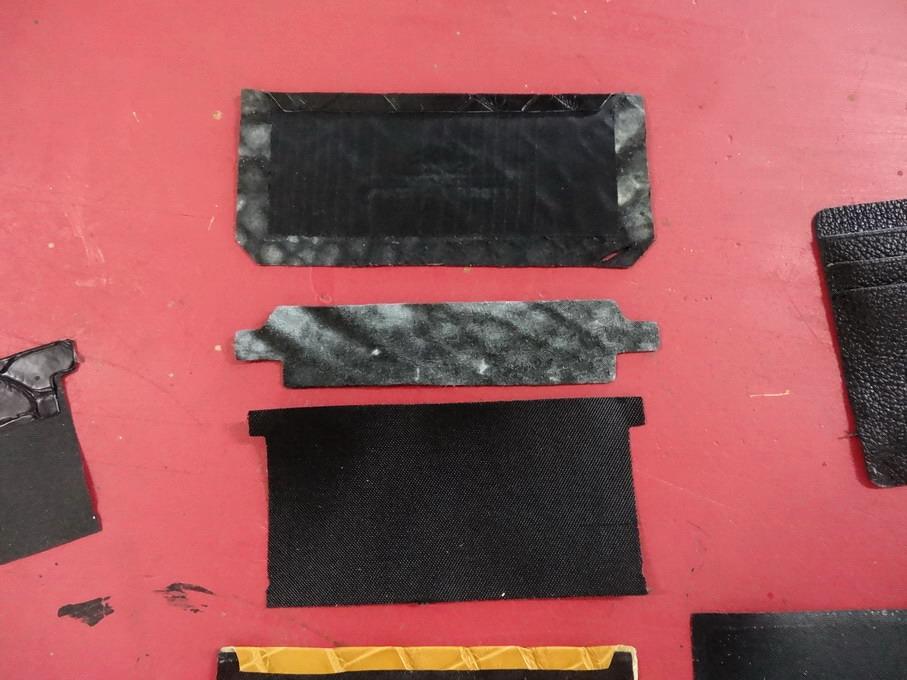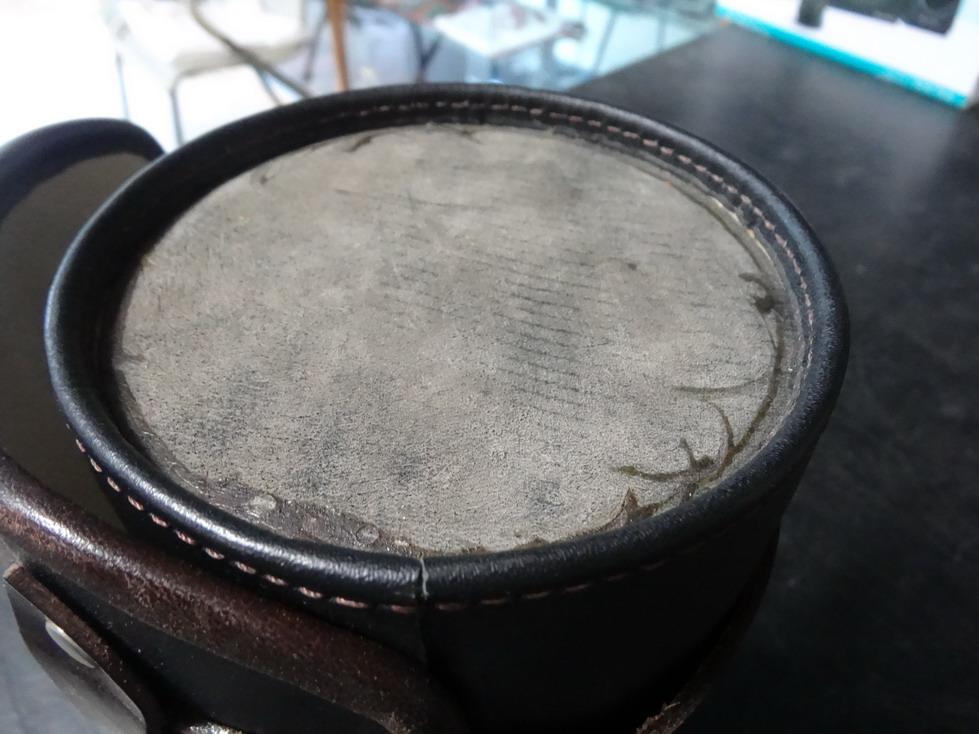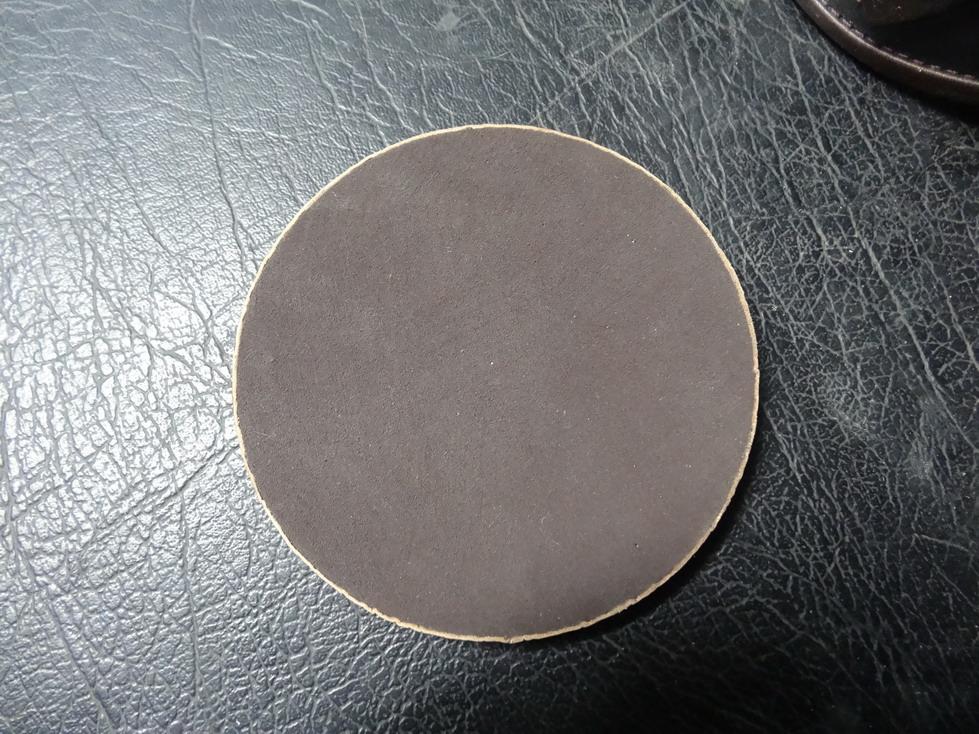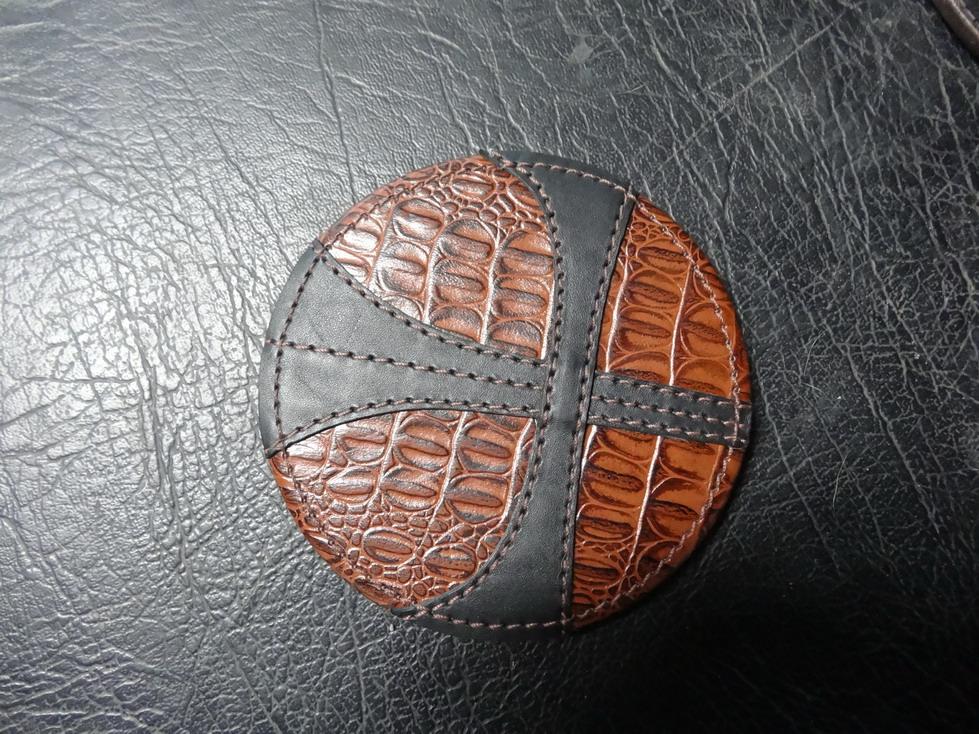-
Posts
3,265 -
Joined
-
Last visited
Content Type
Profiles
Forums
Events
Blogs
Gallery
Everything posted by RockyAussie
-
Yep and probably my daughter in law as well at times. That's alright though caus she knows more than me a lot of the time.
-
Hi @mike02130 , yep ...I am Brian but my wife and I called the business "Wild Harry" after a wild dog we owned at the time called "Harry". My wife Mary does the IG stuff mostly and and knows you from there. She says Hi and if you see a little ginger dog in our stuff sometimes ......that'll be Wild Harry
-
Newbie query on lining billfold and making ID pocket
RockyAussie replied to PhilDimashq's topic in How Do I Do That?
Exactly Hey jimi ..just a little tip mate ...warm your corners with a heat gun and lightly give them a little push and roll with a slicker. You will get a nice closed up rounding that way. -
Just saw this post and as I am making up a knife pouch roll this week I thought I may be able to do a few pics as I go of the process for you if it helps. To get a good roll and not make it excessively long you may want to consider alternating the ends that your handles go as shown in another roll that I made a while back. Don't know where in Oz you are but if it helps I would be happy to machine stitch it up for you when its ready. I am close to Rockhampton. Regards Brian
-
@MsEdna My practice on gussets is to cut and attach the fabric so that it finishes about 2mm short of the edges on the sides and 1mm at the bottom. done carefully you would not need to have it fully glued and therefore not need to worry about any glue showing through. That said I buy a fabric which has been sealed on the back side that does not allow the glue to penetrate through. This Fabric is called a tessuto jacquard 100% polyester which we buy in from Italy from Tabru. Around 100 years ago if I remember correctly I used to spray a thinned down coating of pva wood glue onto some fabric to achieve a similar result. Waaay easier to just buy it and no more worries about fraying when you cut it out either. That sounds good to me...... and the elegance of it is more I think in how well you do it. (Those inner curves may be easer to do with a leather piece attached) This pic below shows the Tabru fabric cut out on our clicker press without fraying, note that the fabric in the credit card pocket does not need to go to the sides and this helps to keep the bulk down along the edge and makes for better stitching results when sewn on a sewing machine. Hope this helps some Brian
-
Press Plate Embossing Plate Maker?
RockyAussie replied to whitakermk's topic in Leatherwork Conversation
That is correct. That is also correct. If you look into many tanneries they will have a large embossing type machine with large alloy plates that can give them a wide range of patterns to put over hides. Also you can warm a piece to be stamped ahead and then emboss down into it. This can after cooled down then be further warmed on the back which will shrink the leather a little whilst making the design pop out a little further. -
Making a card holder template in Autocad (Video clip)
RockyAussie replied to Danne's topic in How Do I Do That?
Thanks Chris That is one hell of a lot to pick through. -
Making a card holder template in Autocad (Video clip)
RockyAussie replied to Danne's topic in How Do I Do That?
Man doesn't he make that look easy. I thought I was pretty quick but that is amazing. I love that you can do the flat pattern so easy and makes me think I may just have to have a look into that Fusion 360. I am sort of stuck a bit in more old Auto cad stuff and find it difficult to put in the measurements after the way they do here but it just might be worth the trouble yet. Thanks for the share @chrisash -
Making a card holder template in Autocad (Video clip)
RockyAussie replied to Danne's topic in How Do I Do That?
@Danne I think you have done very well sorting out how to set up up hour own stitch line file in Auto cad. First time I did it it took me over an hour I think and because after you have done it it is set in and you no longer have to do it, it is worth doing. For myself Cad design is a no brainer because I need to design something nearly every other day and having a file like watch bands all in one place means a couple of minutes of copying and altering and bingo it's done and there to alter again if needed. Because I often have to do many repeats of the product and sometimes some variations I like that I can easily go back to my cad drawing and add another 2mm to a tight edge or whatever changes I want in a matter of seconds before going into full production. Thanks for sharing your knowledge with us all as you proceed on your L.W. journey. -
It all comes down to the complexity of the design and what tools you have on hand to work with. It will do all those things onto the leather light enough to mark without burning in getting soot and such but unless you are doing a heap with designs on it may not be worth the time. For me I do most of my patterning in auto cad and previously I printed that onto cardstock and cut it out by hand now I just get the laser to cut the card pattern out all in one operation and it does it a lot better than I can do by hand. To put it straight onto the leather with first cuts second cuts etc would not always be practicable due to the leather stretching around from first cuts and second cuts. If you had your stitch lines in place marked on your first cut piece they would not line up well possibly after you connect pieces then second cut. It could be done with cut out templates in the laser to hold in exact positioning but that would be a time waste if doing one off jobs. It is definitely worth having one for me as it saves a lot of time on patterning and can be great if you want to get into the designs as well.
-
Press Plate Embossing Plate Maker?
RockyAussie replied to whitakermk's topic in Leatherwork Conversation
Chrome tan comes in a very wide range of types but yes you can emboss onto a lot of these types but some of the spongy types can be difficult. Sometimes this type of products can have a packing piece attached to the back to help hold the shape and detail of the design better. -
I am curious if the fact that I have only done my patterns from Auto Cad and printed is the reason I have not had this same issue. I googled printing in sketchup and sore that it is a problem in comparison. This link may be of some help maybe -https://www.instructables.com/id/A-Better-Way-to-Print-Full-Size-in-SketchUp/
-
stop toolbag from flattening when riding
RockyAussie replied to FleurFeroce's topic in Motorcycles and Biker Gear
I would suggest trying some thick veg attached to the back of your gussets should help. Other then that you may want to glue in some extra lining as well and keep the mph under 150 -
I must admit I must have been lucky here as I have had several printers Canon, Brother and Epson styles 1100 which can do A3 and never experienced this problem with any of them. That is of not much help but I suggest that you consider a small diode laser for this work. I started off using one like in this link a couple of years ago and once you get used to it and a good drawing program you will not have to cut the patterns at all. You have to draw the pattern anyway so why not just laser cut it straight up? https://au.banggood.com/EleksMaker-EleksLaser-A3-Pro-2500mW-Laser-Engraving-Machine-CNC-Laser-Printer-p-1003863.html?gmcCountry=AU¤cy=AUD&createTmp=1&utm_source=googleshopping&utm_medium=cpc_bgcs&utm_content=frank&utm_campaign=frank-ssc-AUg-top100-07dp-stage1-0623&ad_id=445107833412&cur_warehouse=AU Once you have the focus right you can get the cut line width down to .25mm on normal printer card stock which is something you can allow for in your drawing pattern if you think necessary. You may find it useful for burning in pictures and other stuff as well. It is fairly easy to build an enclosure and vent fumes away as well as I have done with mine which I have enlarged to be able to get up to full poster size boards. Total cost for building this large and enclosing and adding smoke extraction was considerably under $1000 au. (not including the couple of days labour it took me to build it.) This pic shows how it came standard and I am cutting through some masking tape on a belt for later painting. Here showing removal of the masking tape Because I could not trust myself or my dogs or anyone else to not see the laser going in the open I decided to expand the size and enclose it all at the same time. Here is what it is today. This is a link that shows the very inexpensive but very effective fume removal fan I use - https://www.ebay.com.au/itm/381970877031
-
No problem friend. I forgot to mention that if that skin is a stiff as I suspect then another thing I do at times before any fabric attachment is sand with very rough sandpaper the flesh side in order to break the tension in it down. DO NOT sand for long in any one area as the heat generated negates the purpose because it sets it back stiff otherwise. Also make sure to hold the skin out flat as you go to not sand into the valleys too much. How are you going with your skiver now days? If you are not very confident it may be better to think about just cutting and edging the edges. Cut some thin strip along the tail edge and give it a go before deciding on your new pattern.
-
Would love some help with a startup :)
RockyAussie replied to JamesBrankin's topic in Leatherwork Conversation
@Fukovskiy to answer your questions properly one would need to get a better understanding of the type of product you expect to produce. I realise that you have mentioned "Specialty:Wallets, belts and bags Interested in learning about:Machinery " Unfortunately the machinery required for this can be quite different depending on the style (carved and stamped with burnished edges using veg tan leathers?) I manufacture very little of that but a look at my profile in the about me section would show a very wide range of products and some of the machinery used to make it. The best I can can offer at this stage is to not buy any machinery until you know exactly what that machinery can do for you and how it compares against other similar machines. I would try and stick with reliable brand names like Adler,Pfaff, Comoga, Fortuna but also take into account the local people that would be available to service any of these if needed. If it were not for the Covid restrictions I would say come over and spend a week or so here but I would urge you to find any local manufactures that would be willing to help you make good decisions with this. I would offer to pay them to show you how the machinery works, how to do the adjustments etc. I have wasted many thousands of dollars over the years getting machinery that is not really ideal for the required work and I could have saved a lot by paying the right people for advice before I started off if I could have found them then. You will see in my profile where I make use of a laser and 3D printer a lot these days and I would make sure I had those on my shopping list early. They save me huge amounts of time and money compared to how I had to do things some years ago. Brian -
Inconsistent stitches, leather lifting, loose thread
RockyAussie replied to JeannieH's topic in Leather Sewing Machines
The centre foot is not holding that thin leather down consistently enough and changing the needle to a leather point (LR) or (TRI) will help but you may need to go up to a size 19 as well. A centre foot that comes down both sides of the needle would be better but that may not work for your application but chances are your application would not need to be that thin and soft either. -
The patterning does not look too bad. The skin will need some taming as it appears to be traditional tanning/glazing and may be heavy on the veg tanning going on the under colour I see. With this type of skin you need to quite a few preparation steps as follows - Cut it out so that the it is about 1/4 bigger all around than you finished size. When you cut it out you will see that the skin relaxes and your straight cut lines will be all bowed and not much like your pattern. Next recut the skin to straighten up a bit but still leave it 1/8" oversize around the edges. Now you will need to skive around those edges at least 1/2" in but no thinner than .5mm at the outer edge or you will get holes showing up in all the valleys. (sportif diagonal is way easierfor this part) . Next is to cut some open weave cotton drill about 3/8" smaller than your your outside pattern pieces all around and then fully glue it onto the flesh side of the skin and follow this by covering the top side with some glad wrap and then I use pieces of Masonite smooth side down to rest on top. I then put some weight on top to set overnight. Do not overweight it or you will have the scales end up sitting down too flat and it does not look so good. This process controls how the croc/gator skin bends and folds and stops it from having localised popped out bits on the finished article. The tail section may be good if you can slip the pattern up on one side next to the clacker hole. If not big enough the lid fold could be pretty bad not to mention folding the edges on those round lid corners etc. Could you give me some dimensions to work with and I will draw up a pattern and might make up one along with you if you like. Alternatively I have quite a few bag orders to start on in the next week or 2 and I could picture some of the relevant parts as I go.
-
Looks like you are getting better at it mate. To offer any constructive criticism on the construction techniques I think we would have to see how you made it or know what stiffener and padding types and thicknesses and the cut out design of them. You may need a heaver stiffener support at the front flap edge if you want to keep using that type of snap fastener but I would think about going to a spring clip type or perhaps small magnets. As to the gusset stitching method I will add that most makers will fake stitch the outer piece and attach it at the tops only. If sanded and glued and hammered down onto a purpose made block it will look better and never come apart if you do it right. The lid flap would be stitched together though. Doing the above using your current method in glazed alligator would be very difficult and the skiving will really come into play. Look for the smaller scale stuff between and above the back legs area if you can or up into the head chin area. If you don't mind the scales going diagonally you will find that it behaves better when it folds on the edges as you tend to not get the furrows in the scale lining up on your folded edge so much. Also the lid flap will not be as likely to have kinks show up when it is down.
-
Can I do this on a cylinder machine ???
RockyAussie replied to chainftw's topic in Leather Sewing Machines
Closest machine for the job that I can think of would be the Techsew 2600- https://www.techsew.com/us/techsew-2600-narrow-cylinder-leather-industrial-sewing-machine.html That would get you about 7mm in from the edge and thread up to 138. Some bigger diameter cylinders will get close as well with some modifications but I like the small diameter for other bags and stuff myself. On the end I decided to go with an end cap to fill the hole as shown in the following pictures. This is easier to do if you have a 3d printer as you can just print the diameter and depth of cap you want to cover instead of sanding down a eva rubber as I did in these pictures. This one is the finished bag Looking inside and note the gusset end position The stitch on the outside goes into the lining only and a leather filler cap is glued and pushed into the gap first The end cap is made with design stitched on then attached to a eva foam to fit firmly into place. This piece was the fake croc test piece. This shows the back of the plug ready to glue up and push into place. All the thread in this case is 138 (20M) Note: I don't believe a shoe patcher will give you the quality of stitching that you would want with this type of job myself. If you do go with the Techsew make sure it is the type with the oscillating dog foot and not one set up for binding. -
The most common method I use is to draw out the pattern generally 2.5mm oversize along with the finish cut sizes to be done. This then gets printed out on light card which then gets a light spray of contact glue applied to it. Once dry I then can place the card pieces onto a cutting board to cut them out. The advantages are that the contact glue helps to stop the card from moving around on the leather as you go on to cut it. having the rest of the drawing on top makes sure that you can see the alignment is where it should be as you go onto the second cutting steps. Some of this can be seen in this earlier post I did awhile back - Nowdays I often get my laser to draw the pattern on top of card (green lines) and cut out the design all in the one operation and sometimes I elect to 3D print the shapes out If I need to do multiples without going so far as getting clicker knives made up. Some of this can be seen in this earlier post - Brian
-
You can see at about 40 seconds in where they are forming the curve for the lid over a wooden piece and that the lining is a little over size which would go onto be trimmed off later. The Saint-Laurent purse above is folded on the lining edge (great then no edging colour is needed) which means that the exact size of all of the pieces have to come together just right. The base fold you need to allow for a 180 degree fold as it does not need to open as much and the lid you need to only allow a 90 degree fold as that has to open and close. To some degree you need to get the thickness of all the materials used in the making and put this together on a strip at say 20mm (3/4") wide and fold and trim it as that is then your ruler guide. Warning.. the Dior bag construction is way easier to get than the purse with the folded bottom but if you need to put fittings in first then that is the way to go as shown a bit in a couple of pictures of bags below that I make pretty regularly. This is showing the lining section ready to go in to the outer section behind it -
-
That is some unbelievably great skiving shown here and I hope one day you can show the technique to all here.





